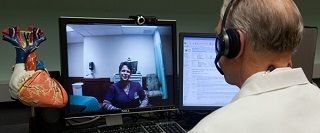From a Guest Blogger: How Technology and Communications Work Together to Improve Healthcare

Digital Apps
Within the past year or two there has been a literal explosion in digital apps that were developed to improve healthcare through better and more rapid communications with doctors and clinics. From mobile phone apps to wearable apps, doctors can now consult with patients remotely in real time. From apps that monitor glucose levels in the blood to those that monitor heart function and brain activity, doctors can immediately respond to emergencies without even seeing the patient in their offices!
Video Conference
When it comes to the need for an immediate ‘visual’ diagnosis, video conferencing has proven to be quite effective. Doctors can consult amongst themselves or actually view patients via web cam video conferencing which frees up clinic space for regularly scheduled patients. Doctors throughout the UK have been utilising video conferencing for patient care as well as for consults amongst themselves, which has proven to be a remarkable time-saving improvement.
Same Day Lab Deliveries
Although automobiles are not considered to be ‘new’ technology, the speed at which they can now travel alongside their fuel efficiency has made their use available to healthcare providers more than ever before. Sometimes a visual diagnosis isn’t possible and digital apps can only test so many body functions. When blood, urine or other biological samples need to be sent off to laboratories across the country, a same day courier service makes it possible.
A patient in Lancashire County may be suffering from symptoms his or her doctor cannot readily identify. The nearest Doctor’s Laboratory is in Manchester so the GP will summon a Manchester couriers company to pick up and deliver a specimen to the lab in the same day. A potentially lifesaving diagnosis can be made within 24 hours due to the rapidity in which the specimens and communications were enabled.
So many innovations in healthcare are made possible by the intersection of communications and technology. As time goes on, these advances will only improve and it can be expected that more and more lives will be saved as a result. Not only is it possible to save lives, but the financial problems besting healthcare can be alleviated to some extent as well. Doctors can now ‘see’ more patients remotely, saving precious time within surgeries and clinics. Technology and rapid communications work together to improve treatments whilst providing cost effective services at the same time.
